Abstract
Cultured fibroblast cells derived from a skin biopsy sample taken from normal human adult were exposed to a potent carcinogen, 4-nitroquinoline 1-oxide. Alterations of cell growth pattern such as higher density and piling up of cells were noticed in some fractions of cultures that were successively subcultured after nitroquinoline oxide treatment. Morphologically altered cells retained this growth pattern and became established lines of transformed cells without showing the limited life-span characteristic of normal cells in culture. The transformed cells showed a higher saturation density and the ability to grow in soft agar, properties that are usually correlated with neoplastic transformation of cells in culture. Selection of preexisting transformed human cells as a mechanism of this observed transformation seemed unlikely because clones of these normal cells could also be used to assess the transforming effect of nitroquinoline oxide. Preliminary results suggest that numerous cell divisions were required for the development of the transformation after nitroquinoline oxide treatment of these human cells.
When the transformed cell lines were injected subcutaneously into nude (athymic) mice, solid tumors were produced at the site of inoculation.
Treatment with N-methyl-N′-nitro-N-nitrosoguanidine also induced cell transformation, in a manner similar to treatment with nitroquinoline oxide. However, transformation was not induced with (i) 4-aminoquinoline 1-oxide (a noncarcinogenic derivative of 4-nitroquinoline 1-oxide), (ii) 3-methylcholanthrene (a carcinogen that cannot be metabolically activated by the target cells employed), or (iii) the solvent dimethyl sulfoxide.
Keywords: morphological alteration, growth in soft agar, transplantability in nude mice, 4-nitroquinoline 1-oxide
Full text
PDF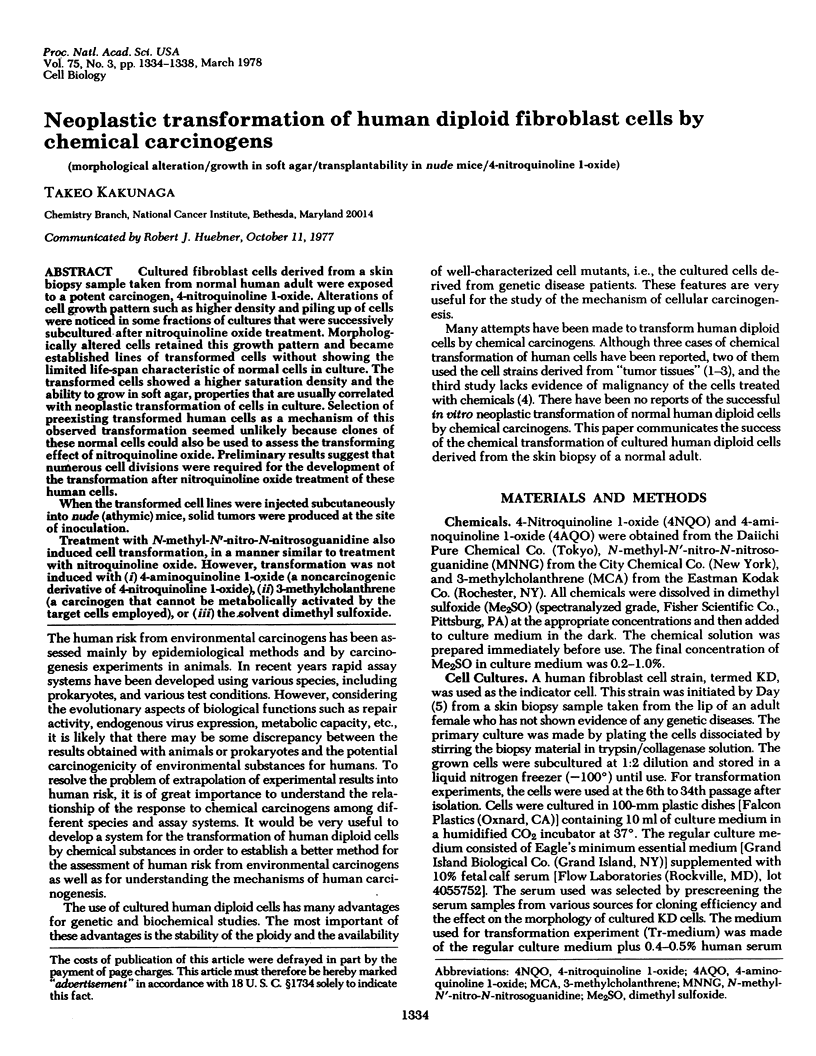
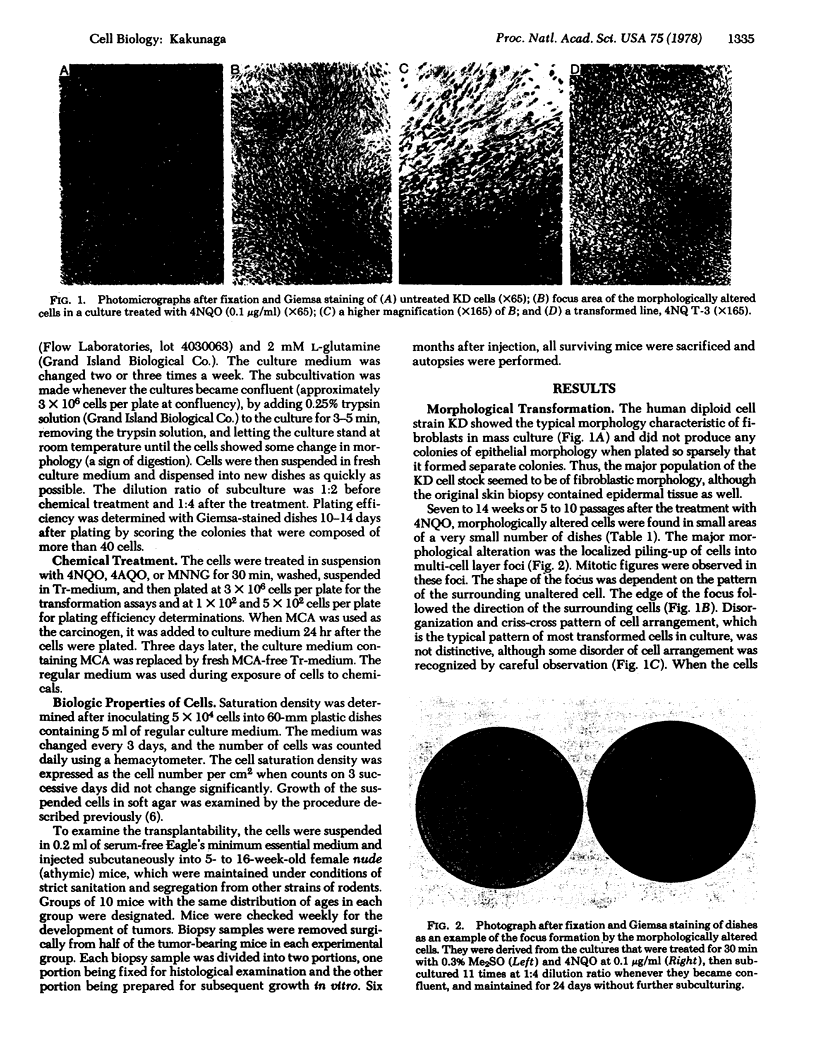
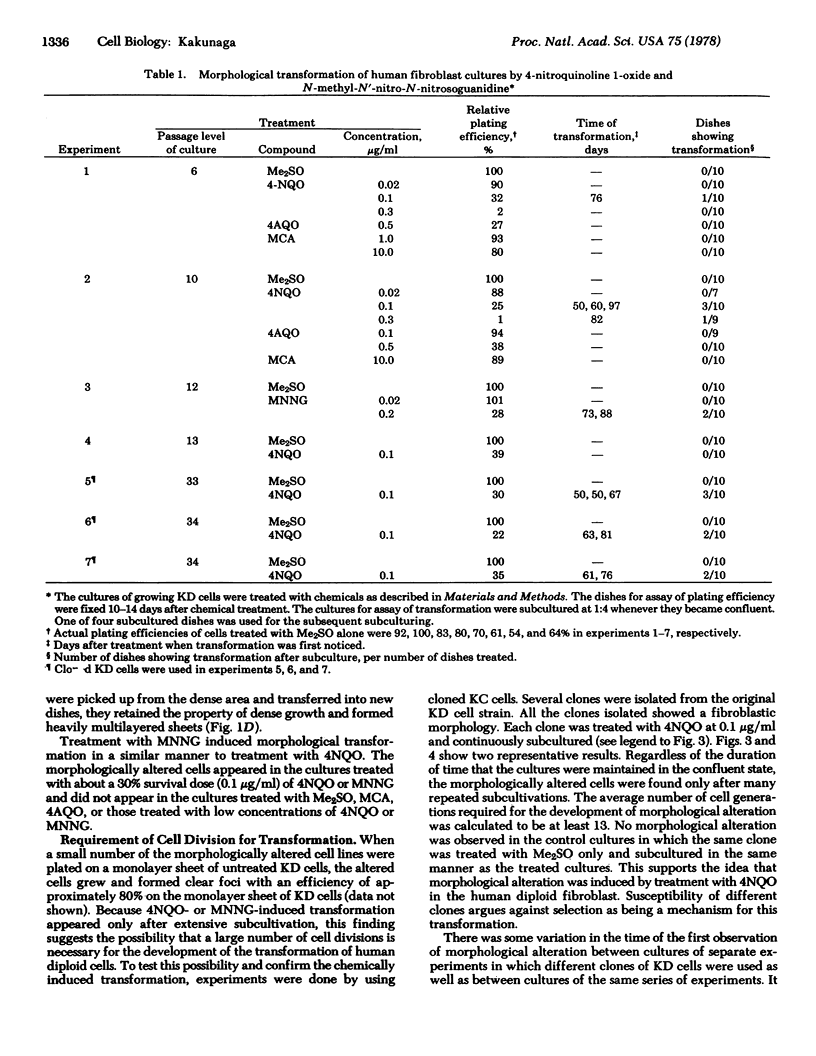
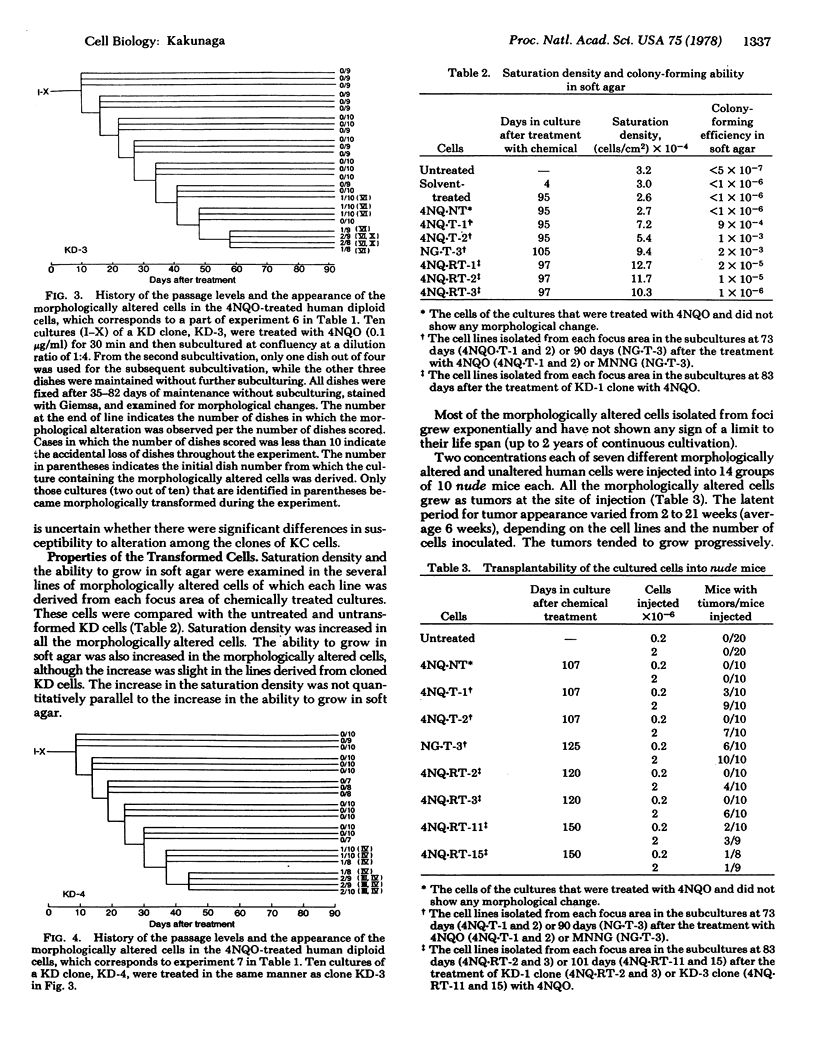
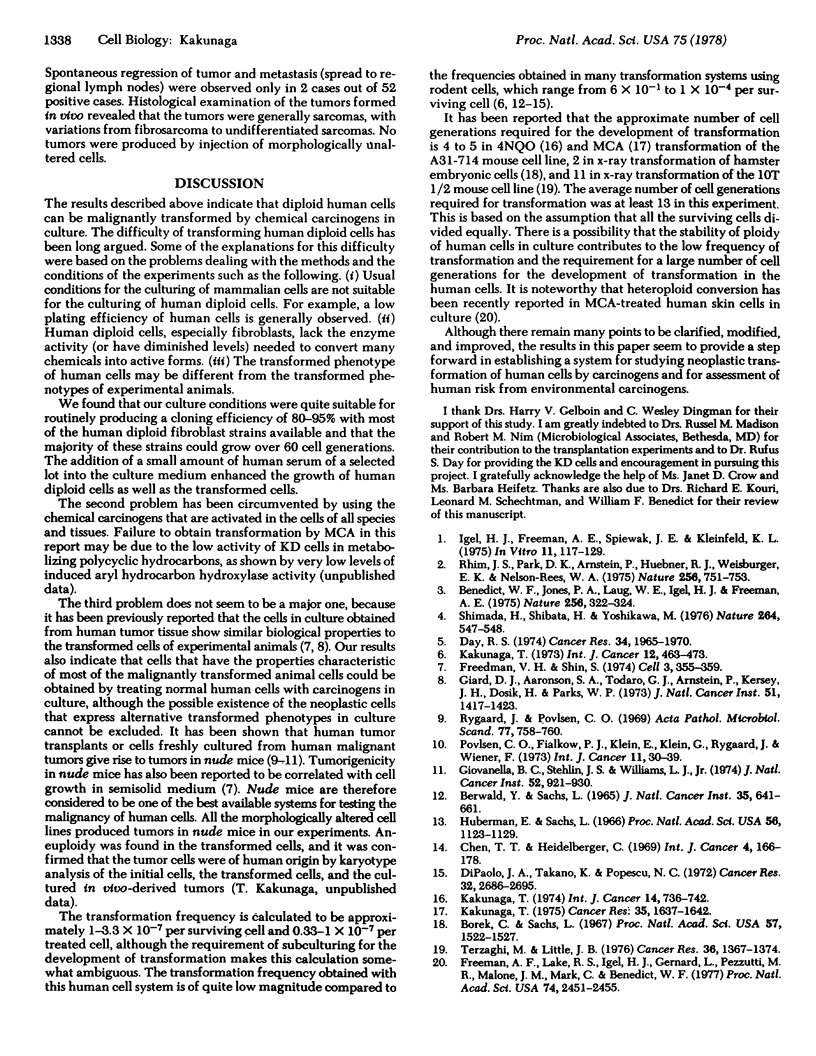
Images in this article
Selected References
These references are in PubMed. This may not be the complete list of references from this article.
- Benedict W. F., Jones P. A., Laug W. E., Igel H. J., Freeman A. E. Characterisation of human cells transformed in vitro by urethane. Nature. 1975 Jul 24;256(5515):322–324. doi: 10.1038/256322a0. [DOI] [PubMed] [Google Scholar]
- Berwald Y., Sachs L. In vitro transformation of normal cells to tumor cells by carcinogenic hydrocarbons. J Natl Cancer Inst. 1965 Oct;35(4):641–661. [PubMed] [Google Scholar]
- Borek C., Sachs L. Cell susceptibility to transformation by x-irradiation and fixation of the transformed state. Proc Natl Acad Sci U S A. 1967 May;57(5):1522–1527. doi: 10.1073/pnas.57.5.1522. [DOI] [PMC free article] [PubMed] [Google Scholar]
- Chen T. T., Heidelberger C. Quantitative studies on the malignant transformation of mouse prostate cells by carcinogenic hydrocarbons in vitro. Int J Cancer. 1969 Mar 15;4(2):166–178. doi: 10.1002/ijc.2910040207. [DOI] [PubMed] [Google Scholar]
- Day R. S., 3rd Studies on repair of adenovirus 2 by human fibroblasts using normal, xeroderma pigmentosum, and xeroderma pigmentosum heterozygous strains. Cancer Res. 1974 Aug;34(8):1965–1970. [PubMed] [Google Scholar]
- DiPaolo J. A., Takano K., Popescu N. C. Quantitation of chemically induced neoplastic transformation of BALB-3T3 cloned cell lines. Cancer Res. 1972 Dec;32(12):2686–2695. [PubMed] [Google Scholar]
- Freedman V. H., Shin S. I. Cellular tumorigenicity in nude mice: correlation with cell growth in semi-solid medium. Cell. 1974 Dec;3(4):355–359. doi: 10.1016/0092-8674(74)90050-6. [DOI] [PubMed] [Google Scholar]
- Freeman A. E., Lake R. S., Igel H. J., Gernand L., Pezzutti M. R., Malone J. M., Mark C., Benedict W. F. Heteroploid conversion of human skin cells by methylcholanthrene. Proc Natl Acad Sci U S A. 1977 Jun;74(6):2451–2455. doi: 10.1073/pnas.74.6.2451. [DOI] [PMC free article] [PubMed] [Google Scholar]
- Giard D. J., Aaronson S. A., Todaro G. J., Arnstein P., Kersey J. H., Dosik H., Parks W. P. In vitro cultivation of human tumors: establishment of cell lines derived from a series of solid tumors. J Natl Cancer Inst. 1973 Nov;51(5):1417–1423. doi: 10.1093/jnci/51.5.1417. [DOI] [PubMed] [Google Scholar]
- Giovanella B. C., Stehlin J. S., Williams L. J., Jr Heterotransplantation of human malignant tumors in "nude" thymusless mice. II. Malignant tumors induced by injection of cell cultures derived from human solid tumors. J Natl Cancer Inst. 1974 Mar;52(3):921–930. doi: 10.1093/jnci/52.3.921. [DOI] [PubMed] [Google Scholar]
- Huberman E., Sachs L. Cell susceptibility to transformation and cytotoxicity by the carcinogenic hydrocarbon benzo[a]pyrene. Proc Natl Acad Sci U S A. 1966 Oct;56(4):1123–1129. doi: 10.1073/pnas.56.4.1123. [DOI] [PMC free article] [PubMed] [Google Scholar]
- Igel H. J., Freeman A. E., Spiewak J. E., Kleinfeld K. L. Carcinogenesis in vitro. II. Chemical transformation of diploid human cell cultures: A rare event. In Vitro. 1975 May-Jun;11(3):117–129. doi: 10.1007/BF02615420. [DOI] [PubMed] [Google Scholar]
- Kakunaga T. A quantitative system for assay of malignant transformation by chemical carcinogens using a clone derived from BALB-3T3. Int J Cancer. 1973 Sep 15;12(2):463–473. doi: 10.1002/ijc.2910120217. [DOI] [PubMed] [Google Scholar]
- Kakunaga T. Requirement for cell replication in the fixation and expression of the transformed state in mouse cells treated with 4-nitroquinoline-1-oxide. Int J Cancer. 1974 Dec 15;14(6):736–742. doi: 10.1002/ijc.2910140607. [DOI] [PubMed] [Google Scholar]
- Kakunaga T. The role of cell division in the malignant transformation of mouse cells treated with 3-methylcholanthrene. Cancer Res. 1975 Jul;35(7):1637–1642. [PubMed] [Google Scholar]
- Povlsen C. O., Fialkow P. J., Klein E., Klein G., Rygaard J., Wiener F. Growth and antigenic properties of a biopsy-derived Burkitt's lymphoma in thymus-less (nude) mice. Int J Cancer. 1973 Jan 15;11(1):30–39. doi: 10.1002/ijc.2910110105. [DOI] [PubMed] [Google Scholar]
- Rhim J. S., Park D. K., Arnstein P., Huebner R. J., Weisburger E. K., Nelson-Rees W. A. Transformation of human cells in culture by N-methyl-N'-nitro-N-nitrosoguanidine. Nature. 1975 Aug 28;256(5520):751–753. doi: 10.1038/256751a0. [DOI] [PubMed] [Google Scholar]
- Rygaard J., Povlsen C. O. Heterotransplantation of a human malignant tumour to "Nude" mice. Acta Pathol Microbiol Scand. 1969;77(4):758–760. doi: 10.1111/j.1699-0463.1969.tb04520.x. [DOI] [PubMed] [Google Scholar]
- Shimada H., Shibuta H., Yoshikawa M. Transformation of tissue-cultured xeroderma pigmentosum fibroblasts by treatment with N-methyl-N'-nitro-N-nitrosoguanidine. Nature. 1976 Dec 9;264(5586):547–548. doi: 10.1038/264547a0. [DOI] [PubMed] [Google Scholar]
- Terzaghi M., Little J. B. X-radiation-induced transformation in a C3H mouse embryo-derived cell line. Cancer Res. 1976 Apr;36(4):1367–1374. [PubMed] [Google Scholar]




